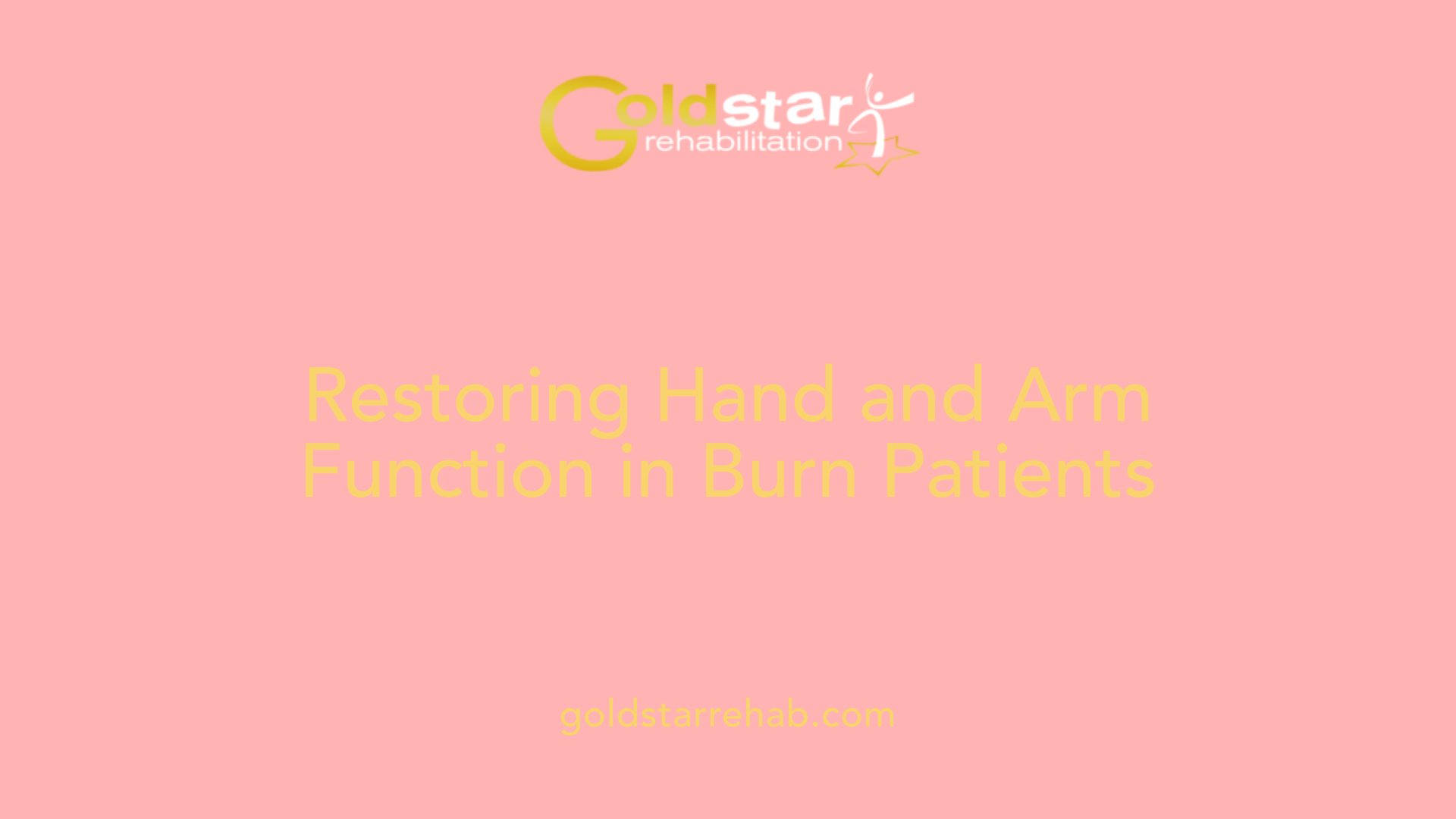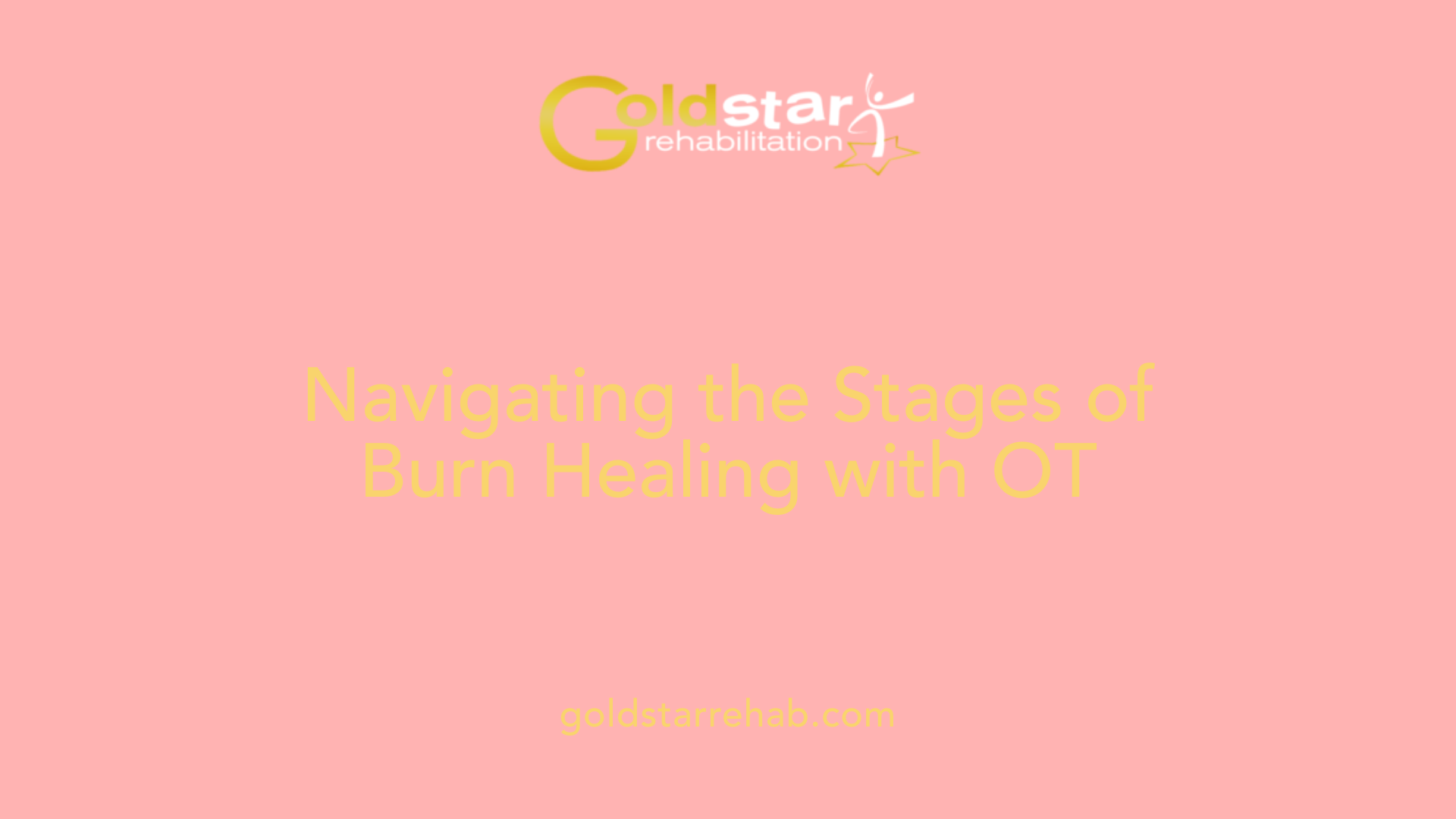How occupational therapy supports individuals recovering from severe burns
Rebuilding Lives: The Critical Role of Occupational Therapy in Burn Recovery
Table of Contents
Understanding the Integral Role of Occupational Therapy in Burn Rehabilitation
Severe burn injuries can have devastating physical and psychological impacts, often altering a patient’s ability to perform daily activities and participate fully in life. Occupational therapy (OT) emerges as a cornerstone of comprehensive burn rehabilitation, focusing on restoring function, alleviating pain, managing scars, and supporting emotional well-being. This article explores how occupational therapy supports individuals recovering from severe burns through tailored interventions that promote independence, improve quality of life, and facilitate community reintegration.
Occupation-Based Rehabilitation and Individualized Treatment Planning

How does occupational therapy support recovery from severe burns?
Occupational therapy (OT) is a cornerstone of burn rehabilitation, providing holistic support to help survivors regain their independence and improve their quality of life. OTs begin with a thorough assessment of the patient's physical, cognitive, and emotional status. This evaluation includes examining the extent of burns, range of motion, strength, sensory perception, and how burns impact daily activities.
Based on this comprehensive assessment, therapists create personalized treatment plans tailored to each individual's needs. These plans incorporate various interventions such as active and passive exercises, stretching, and mobility training. For example, range of motion exercises help prevent contractures, while resistance and strengthening activities rebuild muscle strength.
Scar management is also a vital part of therapy. Techniques like splinting, compression garments, scar massage, and skin care education aim to reduce scar tissue, improve skin flexibility, and restore mobility. Pain and edema are managed through therapeutic modalities, helping patients participate actively in rehabilitation activities.
Occupational therapists use adaptive strategies and assistive devices—such as specialized utensils, grab bars, or mobility aids—to facilitate daily tasks like dressing, grooming, and cooking. These interventions not only promote physical recovery but also support the psychological and emotional well-being of the patient.
The ultimate goal is to restore independence in self-care, mobility, and social participation. Therapists work closely within multidisciplinary teams, including physicians, physical therapists, psychologists, and social workers. This collaborative approach ensures that all aspects of recovery—physical, emotional, and social—are addressed, helping burn survivors return to their routines, work, and community life.
By focusing on personalized, occupation-based rehabilitation, OT plays a vital role in optimizing functional outcomes and supporting long-term recovery after severe burns.
Interventions Across the Phases of Burn Recovery

What are the different phases of burn recovery, and how does occupational therapy contribute in each stage?
Burn recovery from a burn injury unfolds through several overlapping stages, each requiring specialized interventions. Occupational therapy (OT) plays a vital role across all these phases to ensure optimal healing, functional restoration, and psychosocial support.
The first stage is the acute phase, which begins immediately after injury. During this time, the primary focus is on stabilization, controlling pain, managing edema, and preventing complications such as contractures and infections. OT professionals help by assessing the injury, assisting with positioning, and initiating gentle range of motion exercises even when patients are sedated or intubated. Early splinting in the antideformity position and proper wound care are essential to prevent long-term deformities.
Following stabilization, the wound healing phase involves procedures like debridement, skin grafting, and further wound management. OT continues to support by aiding in edema reduction, scar management, and maintaining mobility. Techniques such as scar massage, pressure therapy with garments, stretching, and desensitization are begun to facilitate better skin healing and prevent contractures.
As healing progresses into the long-term rehabilitation phase, the focus shifts towards restoring functional abilities. OT helps patients regain independence in daily activities through activities of daily living (ADL) training, adaptive techniques, and use of assistive devices. Splinting continues to prevent contractures, and exercises aimed at improving strength and flexibility are introduced to maintain mobility.
Psychosocial support becomes increasingly important during this phase. OT professionals address body image concerns, anxiety, and depression, providing counseling and peer support opportunities. Community reintegration, including work and social participation, is facilitated with environmental modifications, vocational training, and travel orientation.
Throughout each stage, occupational therapists work as part of a multidisciplinary team including physicians, physical therapists, psychologists, and support workers. Their continuous involvement ensures that interventions are personalized, holistic, and adaptable, promoting the recovery of physical, emotional, and social well-being.
In summary, from stabilization to reintegration, OT contributes significantly by preventing deformities, restoring vital functions, and supporting emotional health, ultimately guiding burn survivors toward an improved quality of life.
Techniques and Strategies Employed by Occupational Therapists

What techniques and strategies are used by occupational therapists in burn recovery?
Occupational therapists play a crucial role in the holistic recovery of burn patients by implementing a variety of tailored techniques. One of their primary approaches involves the use of splinting and proper positioning from early stages, which helps prevent debilitating contractures and maintains joint mobility. They also use adaptive aids and assistive devices, such as grab bars and specialized utensils, to support independence in daily activities like dressing and grooming.
Scar management is another vital aspect of occupational therapy. Therapists employ techniques including massage, pressure therapy using pressure garments, silicone gel sheets, and sometimes laser therapy to soften scars and enhance cosmetic outcomes. Regular scar massage and skin care education help improve tissue elasticity and reduce tightness.
To restore physical capabilities, therapists design individualized exercise programs that focus on range of motion, muscle strength, and flexibility. These exercises include stretching, strengthening routines, and functional movement training, often supplemented with specialized methods like ultrasound or electrical stimulation.
Patient education is integral to successful rehabilitation. Occupational therapists provide guidance on skin care practices, activity modifications to ease challenges in daily life, and strategies for community reintegration. They also counsel patients on pain management, edema control, and ongoing exercises to maximize functional recovery.
In summary, through a combination of activity adaptation, splinting, scar therapy, and movement exercises, occupational therapists comprehensively address both the physical and psychological aspects of burn recovery. The collaboration within a multidisciplinary team ensures that patients regain independence, improve their appearance, and enhance their overall quality of life.
Supporting Daily Life and Occupational Participation
How does occupational therapy assist in regaining daily activities and occupational participation after burn injuries?
Occupational therapy is essential in helping burn survivors regain independence in their everyday lives. Through personalized interventions, therapists focus on improving skills needed for activities of daily living (ADLs) such as dressing, grooming, bathing, and feeding.
Therapists use targeted techniques including exercises, adaptive strategies, and assistive devices to make these activities easier. For example, they may recommend special utensils or tools to assist with feeding or dressing, or suggest home modifications to accommodate physical limitations.
In addition to physical rehabilitation, occupational therapists provide support in managing emotional and psychological challenges like body image concerns, anxiety, and depression. They often incorporate therapeutic activities and counseling to boost confidence and emotional resilience.
Community participation and returning to work or educational settings are also prioritized. Therapists work on facilitating community activities and training patients in travel techniques, helping them navigate transport and public spaces safely.
Early intervention is vital for better outcomes. A multidisciplinary team typically coordinates care, addressing physical recovery, mental health, and social integration.
By assessing individual needs and setting achievable goals, occupational therapists help burn survivors rebuild their routines, restore function, and regain their roles within society. Their holistic approach ensures improvements in physical abilities, emotional health, and overall quality of life, enabling patients to participate fully in their daily and occupational roles.
Impact on Hand and Upper Extremity Function

What is the impact of occupational therapy on hand and upper extremity function in burn recovery?
Occupational therapy plays a crucial role in the rehabilitation of individuals recovering from burns affecting the hands and upper limbs. Through early intervention, therapists help improve mobility, strength, and dexterity, which are often compromised after a burn injury.
A targeted occupational therapy program includes activities like range of motion exercises, splinting, scar management, and therapy for activities of daily living (ADL). These interventions aim to prevent severe complications such as contractures, which occur when scar tissue tightens and limits movement. Implementing early splinting, particularly in the antideformity position, helps maintain joint flexibility and reduces the risk of permanent deformity.
Research indicates that patients who receive dedicated occupational therapy show substantial improvements in hand function and overall quality of life. For instance, a study measuring the Disabilities of the Arm, Shoulder, and Hand (DASH) scores—a common assessment of upper limb functionality—demonstrated a significant decrease from an average of 60.9 to 33.9 after just 8 weeks of therapy. This reduction reflects enhanced movement and decreased disability, enabling patients to perform daily activities with greater ease.
In addition to mobility and function, occupational therapists assist with scar remodeling, joint positioning, and customized wound care strategies, promoting better healing and cosmetic outcomes. The use of various techniques such as soft tissue massage, silicone gel sheets, and compression garments helps soften scars and improve skin pliability.
Overall, occupational therapy supports the rebuilding of hand and arm functions, helping patients regain independence and return to their routines. Long-term benefits include minimized disability, improved psychosocial well-being, and an increased ability to participate in work and social activities.
What is the significance of occupational therapy in long-term burn recovery?
In the long run, ongoing occupational therapy ensures that gains in mobility are maintained and that patients adapt successfully to any persistent physical or psychological challenges. It aims to restore maximal function, support emotional health, and foster social reintegration, making it an integral component of holistic burn rehabilitation.
Phases of Burn Recovery and OT’s Role in Each Stage

What are the different phases of burn recovery, and how does occupational therapy contribute in each stage?
Burn recovery from a burn injury is a complex process that unfolds over multiple stages, each requiring specific interventions and support. Occupational therapists (OTs) play an essential role throughout this journey, ensuring personalized care that promotes healing, function, and well-being.
The first stage is the acute phase, which begins immediately after the injury. During this period, the primary focus is on stabilization, wound care, and preventing further tissue damage. OTs assess the extent of burns, help with positioning and orthotics, and educate patients about movement fears and pain management. Early interventions include gentle range of motion exercises to prevent joint stiffness, scar management techniques, and edema control—aiming to minimize complications such as contractures and immobility.
Following stabilization, the wound healing phase involves surgical interventions like skin grafting, debridement, and infection prevention. OT involvement here continues with activities to maintain mobility and prepare the patient for rehabilitation. Therapists guide gradual reintroduction of movement, splinting in functional positions, and skin care routines that promote optimal healing and scarring.
As healing progresses, the long-term rehabilitation stage focuses on restoring function, optimizing cosmetic outcomes, and supporting psychological health. OT professionals develop customized programs that include activities of daily living (ADL) training, scar management with compression garments and silicone gels, strengthening exercises, and mobility training. They also work with patients on psychosocial aspects, addressing issues like body image concerns, anxiety, and social reintegration.
Furthermore, OT supports community participation by facilitating travel training, vocational rehabilitation, and home modifications—like installing ramps or grab bars—to enhance independence and safety outside the clinical setting.
Throughout these phases, occupational therapists collaborate closely with surgeons, physical therapists, psychologists, and other healthcare providers. This teamwork ensures a comprehensive approach tailored to each patient’s needs. By guiding patients through these different stages, OT helps maximize functional recovery, reduce disability, and improve overall quality of life.
Search terms for further research
KeywordDescriptionAdditional NotesBurn recovery phasesDetails on the timeline and stages of burn healingGuides in understanding recovery stagesMultidisciplinary approachThe collaborative model of care including OTEmphasizes team coordinationOT interventions burnSpecific therapies used for burn recoveryFocus on physical and psychosocial aspectsRehabilitation after burnsLong-term strategies for functional restorationIncludes physical, emotional, and social support
Pain and Scar Management Strategies
How does occupational therapy help in pain management and scar management for burn survivors?
Occupational therapy plays a vital role in helping burn survivors manage pain and facilitate scar healing. Therapists use a variety of techniques to reduce discomfort, improve skin flexibility, and prevent complications like contractures.
One common approach is scar massage, which involves gentle, systematic massage of the scar tissue. This technique helps soften scars, improve blood flow, and reduce erythema (redness). Regular scar massage can also decrease stiffness and itching, making daily activities more comfortable.
Pressure therapy with specially designed garments or silicone gel sheets is another key strategy. These pressure devices help flatten and soften scars, decrease hypertrophic scar formation, and regulate scar height. Silicone gel sheets, in particular, are widely used for their effectiveness in reducing scar redness, height, and firmness while maintaining skin hydration.
Splinting and proper positioning are incorporated into therapy plans to prevent or correct contractures—permanent tightenings of skin and tissue that can impair movement. Early application of splints helps maintain joint range of motion and reduces pain related to stiffening.
OT interventions also include stretching exercises, joint mobilization, and activities of daily living (ADL) training aimed at restoring function and alleviating pain caused by tight scar tissue.
Moisturizing is crucial; therapists recommend the use of fragrance-free, skin-nourishing lotions to keep the skin supple, enhance scar pliability, and soothe hypersensitive areas.
Holistic burn management involves collaboration among dermatologists, plastic surgeons, psychologists, and therapists to address not only the physical aspects of scarring but also emotional and social concerns. This team-based care ensures comprehensive pain and scar management tailored to each patient's needs.
Overall, structured, early intervention in pain and scar management by occupational therapists promotes better healing, minimizes long-term disfigurement, and enhances overall quality of life for burn survivors.
More about pain and scar management in burn rehab: Search for related resources using the query "Pain and scar management in burn rehab" to learn about the latest techniques and innovations.
The Broader Impact of Occupational Therapy on Survivors’ Lives
Why is occupational therapy essential for improving the quality of life of burn survivors?
Occupational therapy plays a vital role in the comprehensive rehabilitation of burn survivors. It focuses on restoring physical functions, especially of the hands and upper limbs, which are often severely affected by burns. Through techniques like range of motion exercises, stretching, splinting, and scar management, occupational therapists help prevent debilitating contractures and improve mobility.
One of the core components is occupation-based intervention, such as the CO-OP protocol, which enhances hand function and enables patients to carry out daily tasks more independently. Early intervention, sometimes starting even during the acute phase, helps minimize long-term disabilities, allowing patients to regain their capacity to perform routine activities like dressing, grooming, and cooking.
Beyond physical recovery, occupational therapy addresses critical psychological and emotional needs. Many burn survivors face body image concerns, anxiety, depression, and sleep disruptions. Therapeutic activities, counseling, and supportive education help build resilience, improve self-esteem, and foster emotional well-being.
Support in psychological well-being, resilience, and body image is integral to overall recovery. Occupational therapists often work alongside psychologists to address these challenges, promoting positive coping strategies and social participation.
This holistic approach ensures that burn survivors are not only physically healed but also equipped mentally and emotionally to reintegrate into society. Occupational therapy empowers individuals to regain independence and restore their confidence, leading to better social engagement and a higher quality of life.
Ultimately, the combined physical, psychological, and social benefits of occupational therapy help survivors move beyond their injuries to rebuild meaningful, autonomous lives. This comprehensive support substantially enhances their overall well-being and long-term recovery outcomes.
AspectIntervention StrategiesImpact on Quality of LifePhysical recoveryStretching, splinting, scar management, exercisesImproved mobility, reduced contractures, better functioningPsychological supportCounseling, peer support, stress managementIncreased resilience, reduced depression and anxietyDaily activity skillsAdaptive techniques, assistive devicesGreater independence, confidence in daily tasksSocial participationCommunity reintegration programs, educationEnhanced social interaction, improved self-esteem
Through these multidimensional interventions, occupational therapy significantly influences the overall life quality of burn survivors, helping them to achieve meaningful, independent, and satisfying lives post-injury.
Holistic and Collaborative Approach for Optimal Outcomes
Burn rehabilitation is a complex, ongoing journey that benefits immensely from the multidimensional support provided by occupational therapists. By addressing physical, emotional, and social challenges through early and tailored interventions, OT enables burn survivors to regain independence, improve functional capabilities, and enhance their overall quality of life. Working hand-in-hand with a multidisciplinary team—including physical therapists, surgeons, psychologists, and community resources—occupational therapy remains integral at every stage of recovery. This collaborative effort fosters not only physical healing but also psychological resilience and social reintegration, helping individuals rebuild their lives beyond their injuries.
.png)








%20(1).jpg)



.jpg)





.jpg)

.jpg)












